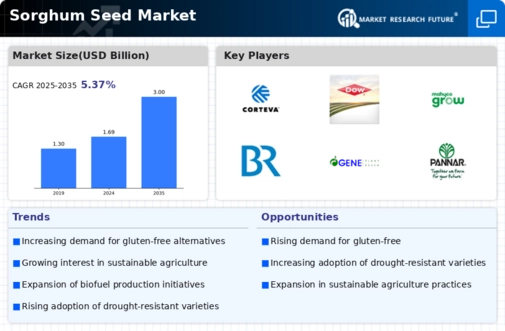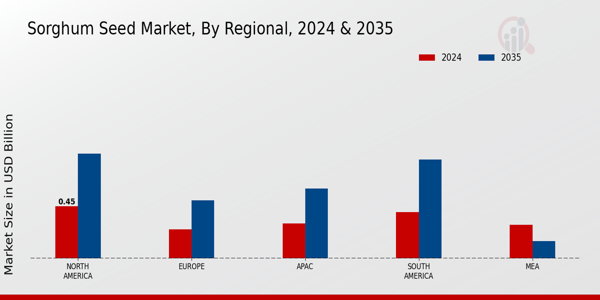Market Growth Projections
The Global Sorghum Seed Market Industry is poised for substantial growth, with projections indicating a market size of 1.69 USD Billion in 2024 and an anticipated increase to 3 USD Billion by 2035. This growth trajectory suggests a compound annual growth rate of 5.36% from 2025 to 2035. Such figures reflect the rising global interest in sorghum as a versatile crop that meets both food and energy needs. The market dynamics are influenced by various factors, including changing consumer preferences, government policies, and advancements in agricultural technology, all contributing to the increasing adoption of sorghum cultivation worldwide.
Government Initiatives and Support
Government initiatives play a crucial role in shaping the Global Sorghum Seed Market Industry. Various countries are implementing policies aimed at promoting sorghum cultivation due to its adaptability and resilience. These initiatives often include financial incentives, research funding, and educational programs to encourage farmers to adopt sorghum as a staple crop. For instance, governments in regions prone to climate variability are increasingly recognizing sorghum's potential to enhance food security. Such support is expected to drive market growth, with a projected compound annual growth rate of 5.36% from 2025 to 2035, as more farmers are incentivized to cultivate this versatile grain.
Health Benefits and Nutritional Value
The Global Sorghum Seed Market Industry benefits from the rising awareness of health and nutrition among consumers. Sorghum is rich in essential nutrients, including fiber, protein, and antioxidants, making it an attractive choice for health-conscious individuals. The grain's gluten-free nature further enhances its appeal, particularly among those with dietary restrictions. As the global population becomes increasingly health-oriented, the demand for nutritious grains like sorghum is expected to rise. This trend is likely to contribute to the market's growth, with projections indicating a potential increase to 3 USD Billion by 2035, as consumers seek healthier food options.
Growing Ethanol Production from Sorghum
The Global Sorghum Seed Market Industry is also influenced by the growing demand for biofuels, particularly ethanol. Sorghum serves as a viable feedstock for ethanol production due to its high fermentable sugar content and efficient growth in diverse climates. As countries strive to reduce their carbon footprints and transition to renewable energy sources, the utilization of sorghum for biofuel production is gaining traction. This shift not only supports the agricultural sector but also contributes to energy sustainability. The increasing interest in biofuels is expected to further stimulate market growth, as more producers explore sorghum as an alternative energy source.
Rising Demand for Sustainable Agriculture
The Global Sorghum Seed Market Industry experiences a notable surge in demand driven by the increasing emphasis on sustainable agricultural practices. Sorghum, recognized for its drought resistance and low input requirements, aligns well with the global shift towards environmentally friendly farming. As farmers seek alternatives to water-intensive crops, sorghum emerges as a viable option. This trend is particularly evident in regions facing water scarcity, where sorghum cultivation offers a sustainable solution. The market is projected to reach 1.69 USD Billion in 2024, reflecting the growing preference for crops that require fewer resources while still providing adequate yields.
Technological Advancements in Seed Development
Technological advancements in seed development significantly influence the Global Sorghum Seed Market Industry. Innovations in breeding techniques, such as genetic modification and marker-assisted selection, are enhancing the yield and resilience of sorghum varieties. These advancements enable the production of seeds that are better suited to withstand pests, diseases, and adverse climatic conditions. As farmers adopt these improved varieties, the overall productivity of sorghum cultivation is likely to increase, thereby attracting more investment into the sector. This trend aligns with the broader agricultural technology movement, which aims to optimize crop performance and sustainability, further bolstering the market's growth.




















